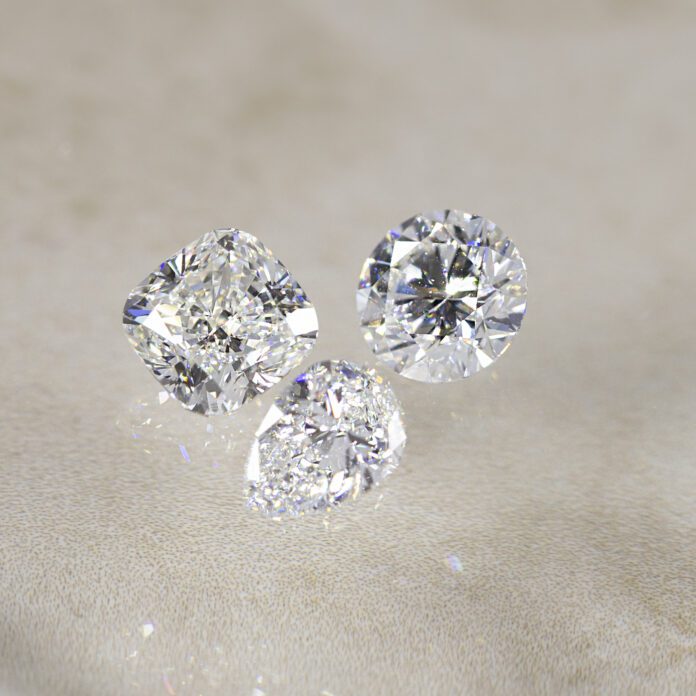If diamonds are reputed to be a “girl’s best friend”, where does moissanite come into play? This increasingly-popular stone is being found more and more often in engagement rings and wedding bands in place of the traditional “best friend”. This is largely due to its innate brilliance, stunning beauty unique capacity to capture light, and its very competitive price.
While some people say that this is just as bad as proposing with a pop ring, we will let you and your beloved be the judge of that. If you feel that beauty, brilliance, and cost-effectiveness are romantic you will end up with a quality item that can last many lifetimes.
Here is everything you need to know about the moissanite stone.
History
According to Sarah O’Dea, of Charles & Colvard, the leading and original creator and moissanite jewelry, moissanite was originally discovered by Dr. Henri Moisson a prize-winning chemist. This discovery of this unique silica carbide was made in the famous meteor crater in Arizona. Moissanite is characterized by a shimmering surface and brilliance of color and is actually one of the rarest stones found on Earth.
But, in the late 1980s, a North Carolina company found a way to create this stone in a laboratory and that is how Charles & Colvard came to be a leading supplier of moissanite jewelry to the wedding industry.
Moissanite versus Diamonds
This brings us to the next question: “what is the major difference between moissanite and diamond?”
Hardness — diamonds have long held the coveted position of the hardest thing on the Mohs scale with a perfect 10 rating. Hardness is important for a jewel that will not scratch and lose its perfect surface. But moissanite is not far behind on this scale with a rating of 9.25. This makes it an especially suitable alternative for engagement rings and wedding rings that you hope will last a long time.
Color — a colorless diamond has a cold and monochromatic brilliance that many people find fascinating. On the other hand, moissanite is a celebration of color, and will even colorless moissanite will exude traces of grey and yellow. In both diamonds and moissanite, color is more defined in larger gemstones.
Brilliance — the capacity to hold and reflect light is what gives a gemstone brilliance. There is a considerable difference between the way moissanite and diamond do this because their faceting patterns are quite different. The ‘fire’ or ‘dispersion’ of a gemstone speaks of how white light is refracted into a split color band through double refraction.
When a beam of light passes through a moissanite gemstone prism it is bent and refracted twice thus increasing the inner fire of the gemstone. In a diamond this is different, and there is only single refraction. Some people prefer the double refractive brilliance of the moissanite stone, but others are partial to the classic brilliance of the diamond. This is a matter of taste.
Price — one of the major deciding factors when choosing between these equally beautiful, durable, and desirable stones is the price tag. The cost of your moissanite ring will depend largely on the size and quality of the stone in question. This is like the diamond’s value that will depend on the rating it receives in the 4Cs. Lab-produced diamonds are also available and are far less expensive than natural stones.
The bottom line on the price question is that a moissanite stone of equal size and brilliance of a diamond will cost considerably less. A 1-carat moissanite stone will cost about $400, but a 1-carat diamond can cost about $4000, this is a considerable price difference.
Now that we have this information in our hands, let us take a closer look at the advantages and disadvantages of the moissanite ring.
Advantages of Moissanite Rings
Moissanite Represents Responsible Consumerism
Moissanite is an ethically produced mineral in which all parties that produce, transport, or sell these products receive fair compensation. Natural diamonds have a more sordid story as they make their way from kimberlite formations deep in mines and riverbeds in far-flung corners of the globe to the glitzy retail outlets in your local mall.
The vast majority of diamonds are found in Africa where large corporations have dug abysmal mines into the surface of the earth to hunt after these rare stones. They can also be found through alluvial mining which is like searching through the mud deposited on the riverbed. Both of these tasks involve considerable labor and much of the work must be done by hand as it has been done since the 19th and 20th centuries. Sad to say, the conditions for the workers have not improved greatly.
Diamond mining is the target of controversy and outrage by the international economic community. Heavy machinery let loose on the fertile countryside is causing considerable pollution and adversely impacting the environment. The workers upon which these operations depend receive shockingly inadequate compensation for the highly-perilous work they perform.
As responsible consumers, products connected to these unscrupulous industrial practices should be marginalized. Moissanite stones offer a perfect solution to sending your coin to the diamond barons and their unethical operations.
Moissanite is Highly Brilliant — or really “Sparkly”
As mentioned above, moissanite is known for its special brilliance in the way it reflects and refracts light. According to the experts, a moissanite stone is easily 10% as brilliant as a diamond. The brilliance of a diamond is measured on the Brilliance Refractive Index (BRI). Moissanite has a BRI of 2.65 – 2.69, making it the most brilliant gemstone known to man, even more than the diamond with a BRI of 2.42.
Moissanite Comes in a Variety of Colors
For those with unique tastes, Charles & Colvert offer a striking array of color options for their moissanite rings. Blues, yellows, and jet black are available in a stunning selection of designs. You may be interested in their lab-created green moissanite ring — a token of their commitment to being environmentally responsible.
The Cost-Effective Choice
A much larger and beautiful moissanite ring will cost far less than a small and fairly unimpressive diamond ring. If you are looking for something beautiful and brilliant that can be passed through generations, you will get more bang for your buck with the moissanite option.
Disadvantages of the Moissanite Ring
Moissanite isn’t Diamond — and therefore not technically “a girl’s best friend”
Putting aside the equal beauty of these two stones, we will admit moissanite lacks the ‘traditional’ value of a diamond. If you were to surprise your betrothed with a moissanite ring on the deck of her father’s home in the Hamptons, she may be utterly mortified. Make sure you have carefully considered the significance of the ring before choosing moissanite.
The color isn’t pure.
The color of a moissanite stone is not as pure as you will find in a diamond. Diamonds have a clarity that is uninterrupted by the slightest hues.
It’s created in a lab.
This may not be a disadvantage; some people prefer lab-produced products to naturally sourced gems for ethical reasons. For others, they fancy the considerable investment of time, energy, and pressure — both within the seething cauldrons of the earth’s core and throughout the oppressive cooperate machine on the surface — that goes into the creation of diamond jewelry.
Help keep news FREE for our readers
Supporting your local community newspaper/online news outlet is crucial now more than ever. If you believe in independent journalism, then consider making a valuable contribution by making a one-time or monthly donation. We operate in rural areas where providing unbiased news can be challenging. Read More About Supporting The West Wales Chronicle

























